
The Power of 10 Mushrooms Packed in Every Gummy
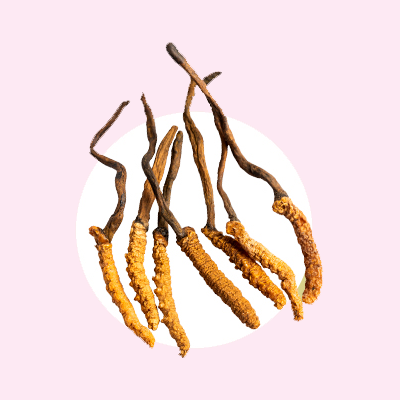
Immunity
Cordyceps
History
Cordyceps is a genus of parasitic fungi that has a
fascinating and diverse history. The term "Cordyceps" is derived from
the Greek words "kordyle," meaning club, and "ceps,"
meaning head, reflecting the characteristic club-shaped fruiting body of these
fungi. The history of Cordyceps involves a blend of traditional medicine,
scientific discovery, and ecological marvels.
Cordyceps, with its rich history and multifaceted significance,
continues to be a subject of scientific research, traditional medicine, and
ecological intrigue. Its unique life cycle and potential medicinal properties
make it a compelling organism that bridges the realms of nature, medicine, and
human exploration.
Benefits
Cordyceps, a genus of
fungi, is believed to offer various health benefits. While some of these
benefits have a basis in traditional medicine, scientific research is ongoing
to understand and validate these claims. Here are some potential benefits
associated with Cordyceps:
- Cordyceps has been traditionally used to improve stamina and endurance.
Some studies suggest that it may enhance aerobic capacity and exercise
performance by increasing the efficiency of oxygen utilization in the body. - Cordyceps is often touted for its potential to combat fatigue and
increase energy levels. It may contribute to reducing the sensation of
tiredness and supporting overall vitality.
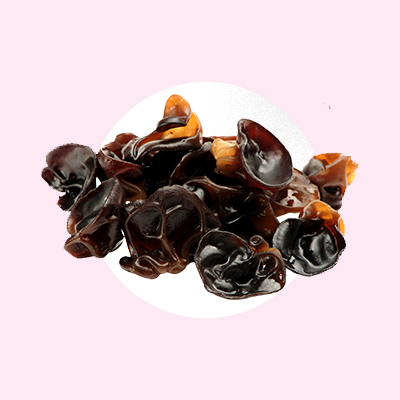
Focus
Turkey Tail
History
Turkey Tail,
scientifically known as Trametes versicolor, is a type of mushroom with a rich
history, particularly in traditional medicine and as a symbol of biodiversity.
Here's an overview of the history of Turkey Tail:
- Turkey Tail has a long history of use in traditional Asian medicine, particularly in China and Japan. In traditional Chinese medicine, it is known as "Yun Zhi," while in Japan, it is called "Kawaratake." For centuries, these cultures have used Turkey Tail and other medicinal mushrooms to promote health
and vitality. - In traditional
Chinese culture, Turkey Tail has been associated with longevity and immortality. The mushroom's distinct fan-like appearance resembles the tail of a turkey, hence its common name. This unique appearance and its vibrant colors have contributed to its symbolic significance.
Benefits
Turkey Tail (Trametes versicolor) is a mushroom that has gained attention for its potential health benefits, particularly in the realm of immune support and overall well-being. While research is ongoing, some of the reported benefits of Turkey Tail include:
• Immunomodulatory Effects:
Turkey Tail mushrooms contain polysaccharides, such as beta-glucans, which may help modulate and support the immune system. These compounds are thought to stimulate the activity of immune cells, enhancing the body's defense against infections and illnesses.
• Antioxidant Properties:
The presence of antioxidants in Turkey Tail, including phenols and flavonoids, contributes to its potential to neutralize harmful free radicals. Antioxidants play a role in protecting cells from oxidative stress and may have implications for overall health.
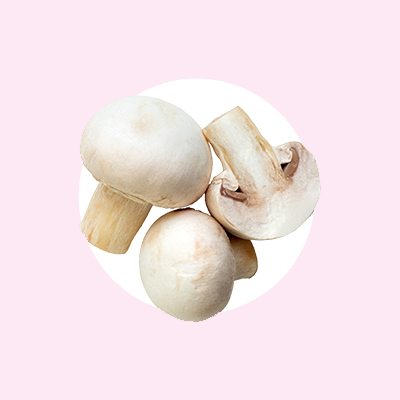
Energy
White Button
History
The White Button Mushroom, scientifically known as Agaricus bisporus, has a rich history and is one of the most widely consumed mushrooms
globally. Here's an overview of the history of the White Button Mushroom:
- Agaricus bisporus is native to grassy areas in Europe and North America. Its wild relatives have been consumed by various cultures for centuries. In the wild, it can be found growing in compost-rich soils, often in association with grasses.
- The cultivation of the White Button Mushroom can be traced back to the 17th century in France. Initially, attempts to cultivate mushrooms were met with challenges, but growers eventually developed successful techniques. The first documented cultivation is credited to French botanist Olivier de Serres in the early 17th century.
- In the 19th century, cultivation techniques for the White Button Mushroom were refined further, and its popularity as a cultivated crop increased. During this time, mushroom cultivation moved beyond France and
expanded to other European countries.
Benefits
White Button Mushrooms (Agaricus bisporus) are not only popular in various cuisines for their mild flavor and versatility but also offer several potential health benefits. Here are some of the benefits associated with White Button Mushrooms:
• Nutrient-Rich:
White Button Mushrooms are low in calories but rich in essential nutrients. They provide a good source of vitamins, including B-vitamins such as riboflavin, niacin, and pantothenic acid, as well as minerals like selenium and copper.
• Rich in Antioxidants:
White Button Mushrooms contain antioxidants, such as selenium and ergothioneine, which help combat oxidative stress in the body. Antioxidants play a role in protecting cells from damage caused by free radicals.
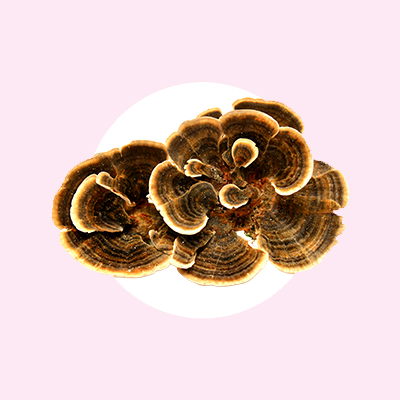
Heart
Black Fungus
History
Black fungus mushrooms, also known as wood ear mushrooms or cloud ear mushrooms, have a long history in traditional Chinese medicine. These mushrooms are dark brown to black in color. In traditional Chinese medicine, black fungus mushrooms are believed to have various health benefits, including improving circulation, reducing inflammation, and promoting overall well-being. They are also thought to be good for the skin and hair.
Benefits
The black fungus mushroom is a popular medicinal mushroom that contains prebiotics which support a healthy gut and help control appetite.
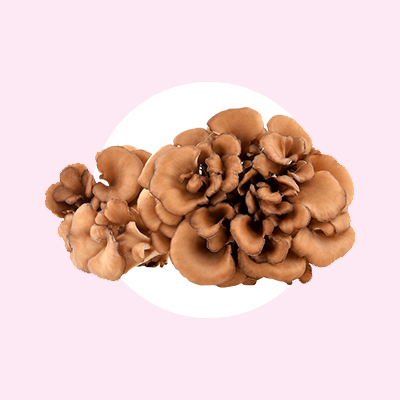
Calm
Royal Sun Extract
History
The royal sun mushroom, also known as Agaricus blazei, have numerous health benefits which have made them popular superfood.
Benefits
Known for Immune system support*, anti inflammatory properties*, antioxidant activity, digestive health*

Energy
Maitake
History
Maitake mushrooms also known as “hen of the woods” are type of medicinal mushroom that has been used for centuries in traditional Chinese and Japanese medicine. Maitake is packed with polysaccharides, triterpenes, and bioactive chemicals to supercharge your immune system and give you a natural energy boost
Benefits
Maitake are rich in beta-glucans, a type of polysaccharide that has been shown to support the immune system*. It contains antioxidants such as ergothioneine and selenium, which can help protect cells from damage caused by free radicals.
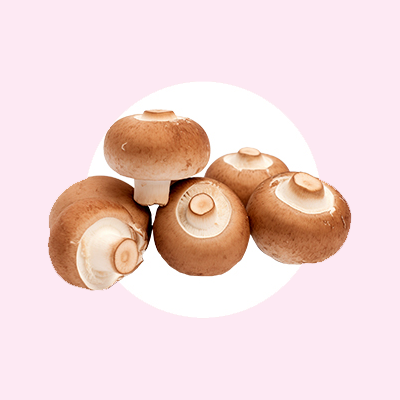
Immunity
Shiitake
History
Shiitake mushrooms (Lentinula edodes) have a long and rich history, deeply rooted in East Asian cultures. Here is an overview of the history of Shiitake mushrooms:
• Origins in China:
Shiitake mushrooms are native to East Asia, with their cultivation dating back over a thousand years. The earliest documentation of Shiitake cultivation is believed to be in China during the Song Dynasty (960–1127 AD).
• Cultivation in Japan:
The cultivation of Shiitake mushrooms spread from China to Japan. Historical records suggest that Shiitake cultivation was well-established in Japan by the late 12th century. During this time, Shiitake mushrooms were primarily grown on natural logs in forests.
Benefits
Shiitake mushrooms (Lentinula edodes) are not only known for their savory taste and versatile culinary uses but are also believed to offer several health benefits. While individual responses may vary, here are some potential benefits associated with the consumption of Shiitake mushrooms:
• Nutrient-Rich:
Shiitake mushrooms are a good source of essential nutrients, including B-vitamins (such as B2, B5, B6, and folate), vitamin D (especially when exposed to sunlight or ultraviolet light during growth), minerals (copper, selenium, zinc), and dietary fiber.
• Immune System Support:
Shiitake mushrooms contain beta-glucans, a type of polysaccharide that has been studied for its potential immunomodulatory effects. Beta-glucans may stimulate the activity of immune cells, enhancing the body's ability to defend against infections and illnesses.
• Antioxidant Properties:
Shiitake mushrooms contain antioxidants, such as ergothioneine and selenium, which can help neutralize free radicals in the body. Antioxidants play a role in protecting cells from oxidative stress.
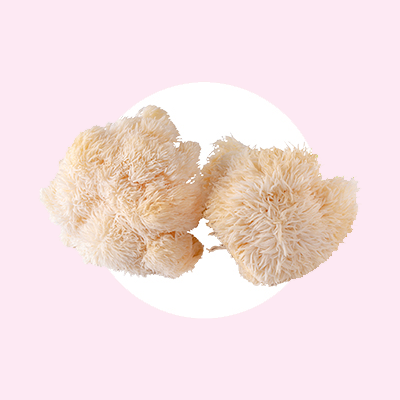
Heart
Lion's Mane
History
Lion's Mane mushroom (Hericium erinaceus) has a long history of use in traditional medicine, particularly in Asian cultures. Here's an overview of the history of Lion's Mane:
• Ancient Asian Use:
Lion's Mane has been used for centuries in traditional Chinese and Japanese medicine. It was highly prized for its potential health benefits, particularly its believed ability to support cognitive function and overall well-being.
• Symbol of Health and Longevity:
In traditional Chinese medicine, Lion's Mane was considered a symbol of health and longevity. It was often reserved for royalty due to its rarity and perceived health-promoting properties.
• Use in Culinary Arts:
Lion's Mane is also valued for its culinary uses. In some Asian cuisines, it is considered a delicacy and used in various dishes. Its unique appearance, which resembles cascading white icicles or a lion's mane, makes it visually appealing in culinary presentations.
Benefits
Lion's Mane mushroom (Hericium erinaceus) has a long history of use in traditional Chinese medicine and has gained popularity in recent years for its potential health benefits. While scientific research is ongoing, some reported benefits of Lion's Mane include:
• Cognitive Health:
Lion's Mane has been studied for its potential neuroprotective effects. It contains compounds that may stimulate the production of nerve growth factor (NGF), which plays a role in the growth, maintenance, and survival of neurons. Some research suggests that Lion's Mane may have cognitive-enhancing properties and could potentially support brain health.
• Memory and Concentration:
Due to its potential neuroprotective effects, Lion's Mane has been explored for its impact on memory and concentration. Some studies have suggested that it may have positive effects on cognitive function, particularly in memory-related tasks.
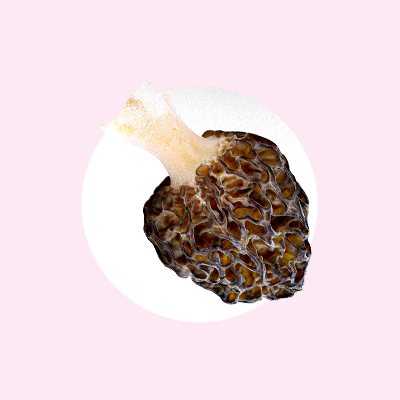
Lungs
Reishi
History
Reishi mushrooms (Ganoderma lucidum) have a long and esteemed history in traditional Chinese medicine, where they are highly regarded for their potential health benefits. Here's an overview of the history of Reishi mushrooms:
• Ancient Chinese Medicine:
Reishi mushrooms have been used in traditional Chinese medicine for over 2,000 years. In ancient texts, they were referred to as "lingzhi," which translates to "spiritual potency." The Chinese considered Reishi mushrooms as a symbol of health, longevity, and spiritual attunement.
• Symbol of Immortality:
Reishi mushrooms were often associated with immortality and used as a tonic for promoting overall well-being and longevity. They were reserved for emperors and high-ranking officials in ancient China due to their rarity and perceived health benefits.
• Taoist Tradition:
In Taoist traditions, Reishi mushrooms were believed to nourish the "Three Treasures" (Jing, Qi, and Shen), promoting vitality, energy, and spiritual awareness. They were considered a superior herb for supporting physical health and mental clarity.
Benefits
Reishi mushrooms (Ganoderma lucidum) are highly regarded in traditional medicine and have gained attention for their potential health benefits. While individual responses can vary, here are some reported benefits associated with the consumption of Reishi mushrooms:
• Immune System Support:
Reishi mushrooms contain beta-glucans and other polysaccharides that may help modulate and support the immune system. They are believed to stimulate the activity of immune cells, enhancing the body's ability to defend against infections and illnesses.
• Anti-Inflammatory Properties:
Compounds found in Reishi mushrooms, including triterpenes and polysaccharides, have been studied for their potential anti-inflammatory effects. These properties may contribute to managing chronic inflammation in the body.
• Adaptogenic Effects:
Reishi is often considered an adaptogen, a substance that may help the body adapt to stress and maintain balance. It is believed to support the body's natural response to stressors, both physical and mental.
• Antioxidant Activity:
Reishi mushrooms contain antioxidants that can help neutralize free radicals in the body. Antioxidants play a role in protecting cells from oxidative stress and may contribute to overall health.
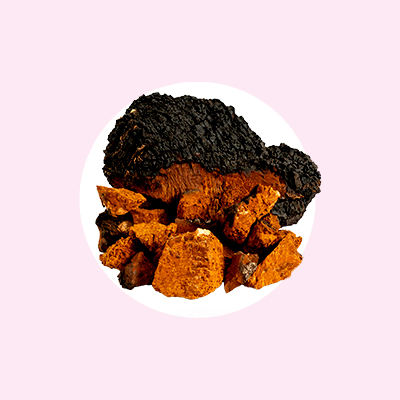
Energy
Chaga
History
Chaga (Inonotus obliquus) is a type of fungus that grows primarily on birch trees in cold climates, particularly in regions like Siberia, Russia, Canada, and some parts of the United States. Here's an overview of the history of Chaga:
• Traditional Use by Indigenous Peoples:
Chaga has a long history of traditional use among indigenous peoples, especially in Siberia and Russia. The Khanty and Mansi tribes in Siberia, as well as the indigenous people of northern Russia, used Chaga as a traditional remedy for various health conditions.
• Russian Folk Medicine:
In Russia, Chaga has been a part of folk medicine for centuries. It was often prepared as a decoction or tea and used to address digestive issues, respiratory conditions, and skin problems. The Russian writer and Nobel laureate Alexandr Solzhenitsyn also wrote about the use of Chaga in Soviet labor camps as a medicinal resource.
• World War II:
Chaga gained some recognition during World War II when Russian soldiers reportedly used it as a coffee substitute. Its popularity as a health-promoting tonic increased during this time.
Benefits
Chaga (Inonotus obliquus) is a type of fungus that has been traditionally used in various cultures for its potential health benefits. While research on Chaga is ongoing, some reported benefits include:
• Antioxidant Properties:
Chaga is rich in antioxidants, including polyphenols. Antioxidants help neutralize free radicals in the body, reducing oxidative stress and supporting overall cellular health.
• Immune System Support:
Beta-glucans, a type of polysaccharide found in Chaga, may help modulate and enhance the immune system. Studies suggest that Chaga may stimulate immune cell activity, promoting a more robust immune response.
• Anti-Inflammatory Effects:
Compounds in Chaga, such as triterpenes and betulinic acid, have demonstrated anti-inflammatory properties. This may contribute to the management of chronic inflammation in the body.
 Log in
Log in


